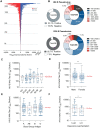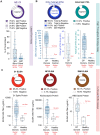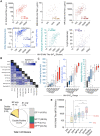This is a preprint.
Serological Assays Estimate Highly Variable SARS-CoV-2 Neutralizing Antibody Activity in Recovered COVID19 Patients
- PMID: 32577675
- PMCID: PMC7302251
- DOI: 10.1101/2020.06.08.20124792
Serological Assays Estimate Highly Variable SARS-CoV-2 Neutralizing Antibody Activity in Recovered COVID19 Patients
Update in
-
Serological Assays Estimate Highly Variable SARS-CoV-2 Neutralizing Antibody Activity in Recovered COVID-19 Patients.J Clin Microbiol. 2020 Nov 18;58(12):e02005-20. doi: 10.1128/JCM.02005-20. Print 2020 Nov 18. J Clin Microbiol. 2020. PMID: 32917729 Free PMC article.
Abstract
The development of neutralizing antibodies (nAb) against SARS-CoV-2, following infection or vaccination, is likely to be critical for the development of sufficient population immunity to drive cessation of the COVID19 pandemic. A large number of serologic tests, platforms and methodologies are being employed to determine seroprevalence in populations to select convalescent plasmas for therapeutic trials, and to guide policies about reopening. However, tests have substantial variability in sensitivity and specificity, and their ability to quantitatively predict levels of nAb is unknown. We collected 370 unique donors enrolled in the New York Blood Center Convalescent Plasma Program between April and May of 2020. We measured levels of antibodies in convalescent plasma using commercially available SARS-CoV- 2 detection tests and in-house ELISA assays and correlated serological measurements with nAb activity measured using pseudotyped virus particles, which offer the most informative assessment of antiviral activity of patient sera against viral infection. Our data show that a large proportion of convalescent plasma samples have modest antibody levels and that commercially available tests have varying degrees of accuracy in predicting nAb activity. We found the Ortho Anti-SARS-CoV-2 Total Ig and IgG high throughput serological assays (HTSAs), as well as the Abbott SARS-CoV-2 IgG assay, quantify levels of antibodies that strongly correlate with nAb assays and are consistent with gold-standard ELISA assay results. These findings provide immediate clinical relevance to serology results that can be equated to nAb activity and could serve as a valuable 'roadmap' to guide the choice and interpretation of serological tests for SARS-CoV-2.
Conflict of interest statement
Conflicts of Interest The authors declare no conflicts of interest.
Figures




References
Publication types
Grants and funding
LinkOut - more resources
Full Text Sources
Other Literature Sources
Miscellaneous
